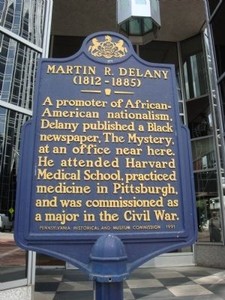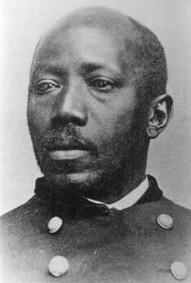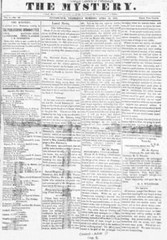Martin R. Delany Historical Marker
Introduction
Text-to-speech Audio
The historical marker at this location commemorates the nearby site of the offices of Martin R. Delany’s newspaper The Mystery. Published between 1843 and 1848, The Mystery was the first African American newspaper established west of the Allegheny Mountains. The Mystery was only one of Delany’s many notable ventures, which together spanned a remarkable career as physician, abolitionist, Black nationalist, and US Army officer. As a resident of the city off and on for decades in the nineteenth century, Delany was one of Pittsburgh’s most famous Black citizens and one of the most prominent African Americans of his day. While the original offices of The Mystery no longer exist, the historical marker commemorating the newspaper’s publications can be viewed here twenty-four hours a day.
Images
Martin R. Delany Historical Marker

Martin R. Delany

Major Martin R. Delany in Uniform
.jpg)
The Mystery

Backstory and Context
Text-to-speech Audio
Martin Robinson Delany was born May 6, 1812 in what is now Charles Town, Jefferson County, West Virginia to Pati and Samuel Delany. His mother was a free Black woman of Mandinka ethnicity whose parents Shango and Graci were royalty from the Niger Valley region of West Africa and were freed in Virginia after a period of enslavement (possibly because of their noble blood). His father, meanwhile, was a slave at the time of Martin’s birth. His parents, like Pati’s, were African nobles but were of the Gola ethnicity from what is now Liberia. Because Virginia law mandated that children inherit their enslaved status from their mothers, Martin was born free and, when an attempt was made to enslave him and his siblings his mother traveled on foot twenty miles to Winchester, Virginia to prove their free status. Growing up, Martin and his siblings learned to read from a copy of The New York Primer and Spelling Book obtained from a traveling salesman (a risky venture with education for African Americans banned in the state of Virginia). When the book’s existence was discovered by authorities in 1822, Pati was forced to flee with her children to nearby Chambersburg in the free state of Pennsylvania. His father followed them a year later after being permitted to purchase his freedom.
In 1831, at the age of nineteenth, Martin Delany moved from Chambersburg to Pittsburgh, Pennsylvania. He continued his quest to expand his education upon his arrival, enlisting in adult classes held by the Trinity African Methodist Episcopal Church on Wylie Avenue. He went on to attend courses at Jefferson College in Washington, Pennsylvania (now Washington & Jefferson College). There, he learned classics, Latin, and Greek under Molliston M. Clark. In 1832, during a cholera epidemic in Pittsburgh, Delany began apprenticing under a series of abolitionist doctors that included Andrew N. McDowell, F. Julius LeMoyne, and Joseph P. Gazzam. From these mentors he learned the prevailing medical science of the time, which centered on the techniques of cupping and leeching. In 1850, he became one of the first three Black men admitted to Harvard Medical School along with Daniel Laing, Jr. and Isaac H. Snowden. Within a month of their entrance to the school, however, Delany, Laing, and Snowden were expelled upon the protests of white students who objected to learning alongside African Americans.
Delany’s expulsion from Harvard significantly impacted his political activities of the time. By 1850, he had long been active in the abolitionist cause. In 1835, Delany had attended his first National Negro Convention in Philadelphia and in 1839 traveled through the southern states to learn more about the conditions of slavery. Four years later, he established The Mystery as the first African American newspaper west of the Allegheny Mountains. Much of The Mystery’s content went on to be republished in other abolitionist papers of the time, most notably famed anti-slavery advocate William Lloyd Garrison’s The Liberator. Garrison was so impressed with Delany’s work, in fact, that he along with Frederick Douglass met with Delany during their visit to Pittsburgh in 1847. The following year, Delany and Douglass began publishing their joint venture the North Star, a newspaper operating out of Rochester, New York. After living in Rochester briefly, Delany returned to Pittsburgh in 1849 before his brief stint at Harvard in 1850. His expulsion from medical school convinced Delany that African Americans would never attain equal rights in the United States. So, in 1852 Delany published The Condition, Elevation, Emigration and Destiny of the Colored People of the United States, the first book-length defense of Black emigration to Africa. This has led many to describe Delany as the first Black nationalist in American history.
Delany returned to Pittsburgh from Harvard and continued his practice as a physician, remaining in the city when many fled during yet another cholera outbreak in 1854. His emigrationist stance took him outside of western Pennsylvania on a number of occasions over the following decade, however. In 1854, he led the National Emigration Convention in Cleveland, Ohio. Two years later, he moved his family to Chatham, Ontario and began serving as an Underground Railroad conductor assisting refugee slaves acclimating to freedom after their escape from the United States. In 1859, he sailed for Liberia, where he signed agreements with local leaders in what is now Nigeria to allow Black emigrants to settle there. In April 1860 he was honored by the International Statistical Congress in London over the objections of white American delegates there. He also around that time published a novel meant as a response to Harriet Beecher Stowe’s Uncle Tom’s Cabin titled Blake; or the Huts of America, in which he sought to make his Black characters less passive than those in the work of his white counterpart. Perhaps his most notable achievement of this period of his life, however, was attaining the rank of major in the United States Army after recruiting Black soldiers for the US Colored Troops after the outbreak of the Civil War in 1861. This particular achievement made Delany the first and highest ranking Black field grade officer in the Union Army.
Delany resumed his political activities after the Confederate rebellion was defeated in 1865, working for the Freedman’s Bureau and Reconstruction government in Charleston, South Carolina for many years. He also continued his support for Black emigration to Africa, joining the Liberian Exodus Joint-Stock Steampship Company in 1878, which was founded to funnel African Americans to Liberia after Reconstruction ended in 1877 and managed to send a shipload of emigrants across the Atlantic Ocean before going bankrupt in 1879. For the next several years, Delany sought unsuccessfully to receive an appointment from the Republican administration in Washington, D.C. In 1884, he returned to life with his family, who had remained in the North during Reconstruction, and resumed his medical practice to make ends meet. The following year, on January 24, 1885, he passed away at the age of seventy-three in Oberlin, Ohio, where he is buried in a family plot that includes his wife and three of his children. In 2006, the National Afro-American Museum and Cultural Center paid for a monument to be erected on the plot commemorating Delany’s life and achievements. The historical marker at this site, noting the location of the offices of his newspaper The Mystery, has been available for public viewing twenty-four hours a day since its placement by the Pennsylvania Historical and Museum Commission in 1991.
Sources
Glasco, Laurence A.. The WPA History of the Negro in Pittsburgh. University of Pittsburgh Press, 2004.
Levine, Robert Steven. Martin Delany, Frederick Douglass, and the Politics of Representative Identity. Chapel Hill. University of North Carolina Press, 1997.
Levine, Robert Steven. Martin R. Delany: A Documentary Reader. Chapel Hill. University of North Carolina Press, 2003.
Rollin, Frank A.. Life and Public Services of Martin R. Delany. New York. Arno Press, 1969.
Sterling, Dorothy. The Making of an Afro-American: Martin Robison Delany, 1812-1885. New York. Hachette Books, 1971.
Historical Marker Database
Wikipedia
Wikipedia
Pennsylvania Newspaper Archive
